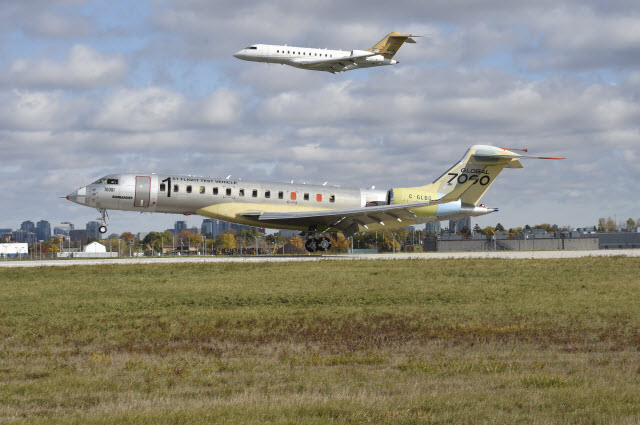By getting the Global 7000 into the air for the first time on 4 November, Bombardier adds to a seven-month string of achievements that have put the manufacturer on a long road to recovery, even as previous delays paint a cloudy market outlook for the company’s longest-range business jet.
The 2h27min flight from Toronto’s Downsview airport kicks off a roughly two-year flight test campaign for the Global 7000, Bombardier’s first new product to enter flight test since the CSeries family in 2013.
“It was very exciting to see our Global 7000 aircraft take to the skies,” François Caza, Bombardier’s vice-president of product development and chief engineer, says in a statement. “The successful conclusion of this process clears the way for the start of our comprehensive flight test program leading to certification.”
The 7,300nm range aircraft at Mach 0.85 is aimed at challenging Gulfstream’s four-year-old dominance in the ultra-long-range, large cabin market sector, fitting neatly between the 7,000nm-range capability of the Gulfstream G650 and the 7,500nm reach of the G650ER.

Bombardier
Speaking ahead of the NBAA convention earlier this week, Bombardier executives claimed the Global 7000 should be in a class itself with a cabin 2.37m (7.78ft) longer than the G650, accommodating four cabin zones instead of three.
The Global 7000 is among a clutch of new markets the business aviation industry is counting on to break out of a forecasted, two-year sales slump that has struck the top of the market especially hard.
For Bombardier, the aircraft also represents a return to form lost during a turbulent period from 2013 to the end of 2015. In that span, the CSeries aircraft suffered multiple delays in flight test, the Global 7000 itself was delayed by two years, the Learjet 85 programme was cancelled and Bombardier’s leadership changed as part of a wider restructuring. The three-year descent also required Bombardier to reset its finances, which ultimately led to spinning off the CSeries into a joint venture with the Quebec government.
But the company has pulled off a string of successful milestones, starting with a landmark CSeries order in April by Delta Air Lines. That was followed by a smooth entry into service of the CS100 with Swiss and the certification of the CS300, which is expected to be delivered to launch customer AirBaltic by the end of the year.
The Global 7000 flight test campaign represents the next challenge for Bombardier’s leadership. The company’s five-year, financial recovery plan depends partly on a smooth path through certification and entry into service of the business jet.
The company’s experience with the CSeries offers several lessons for Bombardier. The Global 7000 shares with the CSeries the same fly-by-wire suppliers and architecture, allowing the business jet to benefit from the lessons learned from the technology that plagued early CSeries development. Rockwell Collins also supplies the integrated avioinics system for both aircraft types. The aircraft differ, however, on propulsion suppliers, with the GE Aviation Passport powering the Global 7000 and the Pratt & Whitney PW1500G pushing the CSeries family.
Source: FlightGlobal.com


























